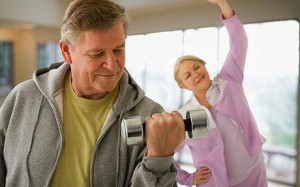For people of all ages, physical activity improves the quality of life in many ways. Physical benefits include improving and increasing balance, strength, coordination, flexibility, and endurance, and if done, results in improved mental health, motor regulation, and diagnostic performance.

An active lifestyle allows older people to make new friends. Stay in the social network and balance with other people of all ages, and improves flexibility, balance, and muscle strength that can prevent falls, which is a major cause of disability. It is found in the elderly. The prevalence of mental illness is lower in people who are physically active.
The benefits of physical activity can be enjoyed even if they start late.
Common diseases of the elderly include cardiovascular disease, arthritis, osteoporosis and high blood pressure.
Although being active from a young age can prevent many diseases, regular activity can prevent the disability and pain caused by these diseases.
Physical activity can help treat brain diseases such as Alzheimer’s and depression.
Organized sports sessions tailored to a person’s level of fitness, or a simple walk can increase the chances of making new friends and connecting with the community and reduce the feeling of mental loneliness needed.
As with all ages, seniors can enjoy participating in physical activity. Anyone with a specific situation or disability that can affect their ability to be active should consult a physician before engaging in physical activity.
Walking, swimming, stretching, gardening, dancing, walking and cycling are the best activities for the elderly.
The number of people over the age of 60 will double in the next 20 years. Most of them will be in developing countries.
Reducing and delaying disability related to aging is a major public health issue, and physical activity can play an important role in creating and maintaining health at all ages.
Physical activity can improve the quality of life for all ages. An active lifestyle allows older people to make new friends, stay in social activities, and interact with others of all ages.
Improving flexibility, balance and muscle strength helps prevent falls, which is a major cause of disability in the elderly. It has been found that the incidence of brain diseases is lower in people who are physically active. Physical activity can help treat some disorders. Think like depression.

Exercises scheduled according to each person’s level of fitness or a simple walk can give the person the opportunity to make new friends and connect with the community and reduce feelings of loneliness and social deprivation. Physical activity can be self-reliance and self-confidence that are basic criteria. In the health of the soul is to increase.
The benefits of physical activity can be used even in old age. Although being active from an early age prevents many diseases, regular mobility and activity in old age also reduce pain and disability associated with diseases such as arthritis, osteoporosis and high blood pressure. help.
Is physical activity only necessary for industrialized countries, and do developing countries have other problems to address?
Lack of physical activity is a major underlying cause of death, disease and disability.
Preliminary data from the World Health Organization’s research on risk factors suggest that inactivity or sedentary lifestyle is one of the top 10 causes of disability deaths worldwide.
In different countries, between 60 and 85% of adults do not have enough mobility to improve their health. A sedentary lifestyle increases all causes of death. It doubles the risk of cardiovascular disease, diabetes and obesity, and significantly increases the risk of bowel cancer. High blood pressure, osteoporosis, depression and anxiety.
In rapidly growing cities, in developing countries, congestion, poverty, crime, traffic, poor air quality, lack of parks, sidewalks, sports and recreation, and other healthy places;
Makes physical activity a difficult choice. In Sao Paulo, Brazil, for example, 70% of people are sedentary. Even in rural areas of developing countries, inactive entertainment such as watching TV is on the rise. As a result of these changes in life, obesity, diabetes and Cardiovascular disease.

Low- and middle-income countries are under a lot of pressure from these and other non-communicable diseases.
77% of all deaths from non-communicable diseases occur in developing countries. These diseases are on the rise and are having an increasing impact on health care systems, resources and the economy in countries around the world.
Countries are working to counter the effects of infectious diseases while increasing the pressure of non-communicable diseases on society and health systems.
Physical activity in addition to a healthy diet and non-smoking is an effective and cost-effective way to promote public health in low- and middle-income countries.
Medical site and health magazine im healthiest

2 Comments
Its like you read my mind! You appear to know a lot
about this, like you wrote the book in it or something. I think that
you can do with some pics to drive the message home a little
bit, but instead of that, this is great blog. An excellent read.
I’ll certainly be back.
What’s up everyone, it’s my first pay a visit at this site,
and piece of writing is truly fruitful in support of me, keep up posting these
content.